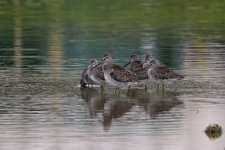Zackiedawg
Well-known member
Yesterday, I went out to some wetlands farther west and north than my usual spots, and there were quite a few wintering ducks and species - shovelers, widgeons, scaups, mergansers. Also there were some shorebirds - large flocks of least sandpipers...and far off in the distance, this gathering of birds with long bills. Without the benefit of the lens to zoom and just eyeing them, I figured they'd be yellowlegs, which are fairly common there...but after taking the shot and looking at them, I think they look more like dowitchers.
I'd appreciate a confirmation from anyone who can ID them - I'm thinking short-billed dowitchers as my most likely pick, but I'm not as deeply familiar with the different varieties of pipers, plovers, and other shorebirds.
I'd appreciate a confirmation from anyone who can ID them - I'm thinking short-billed dowitchers as my most likely pick, but I'm not as deeply familiar with the different varieties of pipers, plovers, and other shorebirds.





